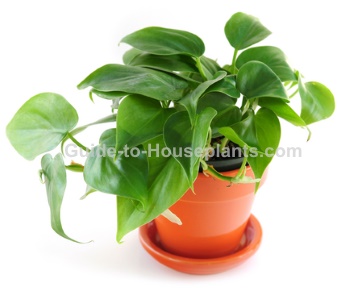Heart-leaf Philodendron
Water your philodendron when the top inch of soil becomes dry to the touch. Using a light weight, well-drained potting media will help ensure that your plant does not become too wet or water logged. While philodendrons prefer high humidity, they are capable of tolerating the low humidity levels of a typical household. Fertilize your philodendron every 3-4 months to keep your plant looking great.
Heartleaf Philodendron
Heart-shaped, glossy leaves emerge bronze, then quickly turn green. The leaves are typically 2-4 in (5-10 cm) long, and cover its long, slender stems that can grow to 4 ft (1.2 m) or more.

Pinch your plant. Without pinching, it will grow with long, single stems and become lanky. You can pinch it back anytime to help it branch out, keeping the plant bushy and full. Always pinch after a leaf node (the place where a leaf is attached to the stem). A new stem will grow from that node.
Pinching tip: Try to pinch close to the node because any bare stem that is left will die, and the node will not grow a new stem. Make a clean cut — you want to avoid jagged tears, which can attract disease. You can use your fingernails to pinch, or use sharp scissors or pruners.
Or let it grow. Few house plants are as eager to climb as a heartleaf philodendron. If you allow the long stems to grow, put the plant in a hanging basket, or let it trail from a shelf or bookcase. To train it to climb a moss pole, use floral tape or soft plant ties to hold the stems up to the pole, until its aerial roots sink in.
It will thrive in a small pot for a couple years with little care. Despite its tropical origins, this beautiful evergreen plant is tolerant of dry air, although it appreciates occasional misting. Keep its leaves clean by wiping them with a damp cloth.
Wondering whether to repot? It’s definitely time to repot every 2-3 years, in spring or early summer. Use a container with drainage holes to prevent root rot. If you want to use a decorative container without drainage, use it as a cachepot — just slip your plain nursery pot into the cachepot. I like to cover the bottom of a cachepot with pebbles to keep the plant above the drainage water.
Problems and Solutions for Heartleaf Philodendron
Wilted leaves are likely because the potting medium has dried out. Although it will tolerate dry soil, I wouldn’t let it go too long without a drink. Another possibility for wilting is root rot.
Yellow leaves are caused by prolonged soggy soil. Overwatering is the number one reason houseplants die. But it’s easy to avoid. Use a pot with drainage holes, water thoroughly then empty the drainage tray.
Brown scorch marks on leaves may be a symptom of exposure to hot, direct sunlight. Or brown spots may be caused by fungus. If you mist your plant, or clean it with water, don’t allow water drops to stay on the leaves. While foliage dries quickly outdoors with good air circulation, indoor plants may stay wet for several hours, leading to fungus. It’s a good idea to cut off affected leaves. Don’t worry — this vigorous vine will soon replace them.
Something bugging your plant? The only problem I’ve had with this easy-going philodendron is fungus gnats. Those tiny, black insects are attracted to wet, peaty potting mixes. They’re difficult to see, but you may find them crawling on the surface. This plant is somewhat drought-tolerant, so I allowed the top couple inches of potting medium to dry out and the fungus gnats disappeared. Aphids are attracted to new growth on soft-stemmed plants, like this one. Treat any infestation right away to avoid pests from traveling on to your other indoor plants.
Heartleaf Philodendron Care Tips
Origin: South America
Height: Climbs or trails to 4 ft (1.2 m) or more.
Light: Moderate to bright light. Small leaves or long spaces between leaves show that the plant is not getting enough light. Move heartleaf philodendron plant to a brighter location, but not into direct sun which can scorch its leaves. It thrives under fluorescent light, too, making it an ideal office plant.
Water: Keep soil lightly moist spring through fall. Allow surface to dry out between waterings in winter. Yellow leaves are caused by overwatering. Always use tepid water for your houseplants because cold water is a shock to these tropical natives.
Humidity: Tolerant of dry air, but likes humidity. Try to maintain 40% relative humidity or higher. Check out these easy ways to raise the humidity around your tropical plants. Brown leaf tips are a symptom of dry air.
Temperature: Average room temperatures (65-75°F/18-24°C). Heartleaf philodendron will tolerate a minimum of 60°F/16°C.
Soil: Peat moss-based mix, such as African violet potting mix.
Fertilizer: Feed monthly spring through fall with a balanced liquid or water-soluble fertilizer, diluted by half. Don’t feed in winter, when growth is slower.
Propagation: Take 3-4 in/7-10 cm-long stem tip cuttings (each with at least 3 leaves attached) in spring or early summer. Cut just below a leaf node (the place where the leaf is attached to the stem). Nodes contain cells that will develop new roots. Philodendron roots easily in water or moist soil.
Recent Articles
Thanksgiving Cactus Care: How to Grow Schlumbergera truncata Indoors

Thanksgiving Cactus is an autumn-blooming house plant. Find out how to make this holiday cactus bloom year after year. Get tips for pruning, repotting and more.
Candy Corn Plant (Manettia inflata) Care for Firecracker Vine Indoors

Candy Corn Plant has long, climbing vines that can be trained on a trellis or grown in a hanging basket. Find out how to care for Manettia as a house plant.
Growing Olive Trees Indoors: How to Grow and Care for this Houseplant

Get tips for growing olive trees indoors. Find out how to grow and care for a dwarf olive tree as a house plant, and what you need to know about pruning.
Copyright © 2008-2023 Guide-to-Houseplants.com. All rights reserved.
Unauthorized duplication or publication of any materials is prohibited and protected by the DMCA.
Guide-to-Houseplants.com is a participant in the Amazon Services LLC Associates Program, an affiliate advertising program designed to provide a means for sites to earn advertising fees by advertising and linking to amazon.com.
Heart-leaf Philodendron

If you’re looking for a fool-proof house plant, you couldn’t do much better than a heart-leaf philodendron. These easy-growing foliage plants thrive with indirect light and very little maintenance.
Heart-leaf philodendrons are often grown in hanging baskets which allow the thin stems and heart-shaped leaves to beautifully spill out of their container.
Characteristics
Heart-leaf philodendron (Philodendron hederaceum var. oxycardium) are a vining type of philodendron with dark green heart-shaped leaves, generally 2–4 inches in size.
Grown in a container indoors, heart-leaf philodendrons can be displayed as a specimen plant on a table, shelf, or wall bracket, where the long, trailing vines of the plant can have room to spread. They can also be trained to climb up a screen, trellis, pole, or a bark board.
For those in warmer climates (USDA hardiness zones 10B through 11) heart-leaf philodendron can also be grown outside for completely different results. As a groundcover, heart-leaf philodendron will quickly provide a dark green carpet in shady areas. When allowed to grow up trees or other vertical supports leaves can grow quite large, reaching 12 inches or more in length. Indoors, the growth of your heart-leaf philodendron will be dependent on the height of their support, training, and pruning.
If you have pets in the house, make sure your heart-leaf philodendron is place where curious paws will not be able to get to it. Philodendrons are toxic to pets; chewing on plants can cause oral pain, drooling, foaming, vomiting, and moderate to severe swelling of the lips, tongue, oral cavity, and upper airway. People can also have mild allergic reactions to the sap, resulting in an itchy rash.
Planting and Care
Philodendrons are versatile and hardy plants, and are generally easy to care for in your home. Heart-leaf philodendrons enjoy bright diffuse light, but will tolerate a range of lighting conditions from diffused light to shade; just avoid direct sunlight as this can burn the leaves.
One of the reasons heart-leaf philodendron does so well indoors is that it prefers the same temperature range as we do; temperatures below 50°F are too cool for this particular plant.
Water your philodendron when the top inch of soil becomes dry to the touch. Using a light weight, well-drained potting media will help ensure that your plant does not become too wet or water logged. While philodendrons prefer high humidity, they are capable of tolerating the low humidity levels of a typical household. Fertilize your philodendron every 3-4 months to keep your plant looking great.
While philodendrons are easy to maintain, too much water or too little light can cause yellowing leaves, and too much fertilizer can cause the leaf tips of your plant to brown and curl. Although generally pest free, they have been known to be infested by aphids, mealy bugs, scales, and spidermites.
Heart-leaf philodendron is also very easy to propagate; you can start new plants for yourself or to share by planting short stem cuttings in clean potting media. This versatile, easy-to-grow plant is a great way for both novices and seasoned gardeners to bring the outdoors in.